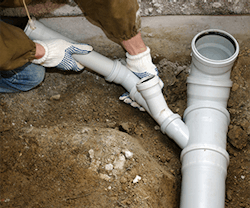How Sustainable are PVC Water Pipes Over 100 Years?
The first of its kind comprehensive environmental and performance review of water and sewer pipes in North America has been released by the Uni-Bell PVC Pipe Association (PVCPA), which covers U.S. and Canadian manufacturers of PVC pipe.
The study uses life cycle assessment methodology to evaluate the cradle-to-grave sustainability of commonly used drinking water and sewer pipe materials, which includes polyvinylchloride (PVC), concrete, ductile iron, and high density polyethylene pipes—over a 100-year service period.
Key findings from the study include:
-
When evaluating the sustainability of piping products for life cycle design, it is important to understand and review the life cycle impacts of all materials used in the piping system, including replacements, support materials, corrosion mitigation, maintenance efforts and water quality treatments required during the service life of pipes.
-
PVC does not serve as nutrient for bacterial growth and pathogens.
-
Keeping pipes in use past their useful service lives results in higher operating and maintenance costs. Internal pipe wall degradation may begin almost immediately after ductile iron and concrete pipes are installed.
-
Traditional definitions of pipe service life should be re-evaluated. For much of the time that iron and concrete pipes are considered “in service,” they in fact are not, since they often do not perform as designed. For a good portion of the time they are in use, iron and concrete pipes are prone to breaks, water loss and water quality issues, as well as higher maintenance and operating costs due to corrosion, which significantly affects pumping efficiency.
-
Metallic and concrete pipes require chemical additives (phosphates) in the drinking water to help reduce pipe wall corrosion. Phosphates increase the chances of bio-growth (such as algae blooms) in drinking water sources, lakes and rivers.
-
Ductile iron pipe produces up to nine times more carbon emissions during raw materials processing, manufacturing, transportation and installation than equivalent PVC pipe.
-
The energy required to pump water through PVC pipe over a 100-year design life remains constant because its smooth walls do not roughen over time. This generates overall life cycle cost savings compared to ductile iron and concrete pipes that require more pumping energy over time due to corrosion, leaks and internal degradation.
-
Corrosive soils affect 75% of water utilities. The durability and corrosion resistance of a pipe greatly affects life cycle impacts. Ductile iron pipe may last as little as 11-14 years in moderately corrosive soils, requiring numerous replacements over 100 years.
“The PVC pipe industry is the only pipe material that has transparently reported their sustainability and environmental impacts,” says SSC President Tad Radzinski. “This is welcome information for both policy makers and utility professionals to make fully informed decisions in their efforts to improve underground infrastructure with sustainable products.”
The report consists of data points and analysis that facility managers and utility professionals can use to develop asset management plans and life cycle cost assessments for water and sewer piping. It can also help to minimize water quality risks and reduce operations, maintenance and repair costs.
More than 200 sources and studies were examined to provide the most up-to-date and thorough industry review of the health, safety, performance characteristics, and sustainability attributes of the different pipe materials available.
The peer-reviewed report also examines other pipe products based on durability, performance and environmental data and statistics when available
“This study provides critical information for federal, state and local policy makers as they look to modern piping materials to help rebuild the nation’s crumbling underground infrastructure. Clean water was identified as a high priority by President Trump and this report confirms that safer, more cost-effective and more durable PVC pipe is key to upgrading America’s drinking water and wastewater systems,” says PVCPA Executive Director Bruce Hollands.
The report in full is available for download here.
